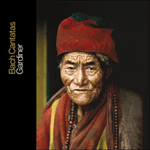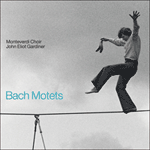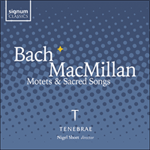The earliest of the six Bach motets is probably the five-part setting of
Jesu, meine Freude, written, it has been suggested, for the funeral service of the wife of the Leipzig postmaster, Johanna Maria Kees, on 18 July 1723. It is also by far the longest and the most complex in its layout. It uses the popular chorale by the poet Johann Franck and the composer Johann Crüger, first published in 1653, but with free passages, added between the six verses, setting words from Romans 8, verses 1, 2, 9, 10 and 11. The result is an ingenious symmetrical structure, typical of the mature Bach. The eleven movements are of three types: settings of the choral tune and text (Nos 1, 3, 7, 11), free settings of the chorale text (Nos 5 and 9), and settings of the added text (Nos 2, 4, 6, 8 and 10). They are grouped around the fugue No 6; Nos 1 and 11 use the same music; Nos 2 and 10 have material in common; and Nos 3–5, a chorale, a trio and a free aria-like movement, have their counterparts in Nos 7–9.
from notes by Peter Holman © 1990
Le plus ancien motet des six motets est probablement le
Jesu, meine Freude à cinq parties, peut-être destiné au service funèbre de l’épouse du maître des postes de Leipzig, Johanna Maria Kees, le 18 juillet 1723. C’est aussi, et de loin, celui qui présente l’agencement le plus long, le plus complexe. Il utilise le choral populaire du poète Johann Franck et du compositeur Johann Crüger, paru pour la première fois en 1653, mais avec, ajoutés entre les six strophes, des passages libres mettant en musique un texte tiré des versets 1, 2, 9, 10 et 11 de l’Épître aux Romains 8. Le résultat est une ingénieuse structure symétrique, emblématique du Bach de la maturité, avec onze mouvements répartis en trois types: mises en musique de l’air et du texte du choral (nos 1, 3, 7 et 11 ), mises en musique libres du texte du choral (nos 5 et 9) et mises en musique du texte supplémentaire (nos 2, 4, 6, 8 et 10). Tous sont groupés autour de la fugue no 6; les nos 1 et 11 utilisent la même musique; les nos 2 et 10 ont du matériau en commun; et les nos 3–5 (un choral, un trio et un mouvement façon aria libre) ont pour pendants les nos 7–9.
extrait des notes rédigées par Peter Holman © 1990
Français: Hypérion
Die früheste der sechs Motetten ist wahrscheinlich die fünfstimmige Vertonung von
Jesu, meine Freude, die wohl für den Trauergottesdienst der Frau des Leipziger Oberpostmeisters, Johanna Maria Kees, am 18. Juli 1723 entstanden war. Dieses Werk ist auch bei Weitem die längste Motette und hat die komplexeste Anlage. Es wird hier der populäre Choral des Dichters Johann Franck und des Komponisten Johann Crüger, der 1653 erstmals erschienen war, verwendet, und zwischen die sechs Strophen sind jeweils Textauszüge aus dem 8. Kapitel des Römerbriefs (Verse 1, 2, 9, 10 und 11) eingefügt. Daraus ergibt sich eine geniale symmetrische Struktur, die für den reifen Bach charakteristisch ist. Die elf Sätze teilen sich in drei Typen: Vertonungen der Choralmelodie mit Text (Nr. 1, 3, 7, 11), freie Vertonungen des Choraltexts (Nr. 5 und 9) sowie Vertonungen des hinzugefügten Texts (Nr. 2, 4, 6, 8 und 10). Sie sind um die Fuge Nr. 6 herumgruppiert; Nr. 1 und 11 verwenden dieselbe Musik; Nr. 2 und 10 teilen musikalisches Material und Nr. 3–5, ein Choral, ein Terzett und ein freier arienartiger Satz haben ihre Gegenstücke in Nr. 7–9.
aus dem Begleittext von Peter Holman © 1990
Deutsch: Viola Scheffel


 Bach: Cantatas Nos 3, 13, 14, 26, 81 & 155
Bach: Cantatas Nos 3, 13, 14, 26, 81 & 155 Bach: Motets
Bach: Motets Bach & MacMillan: Motets & Sacred Songs
Bach & MacMillan: Motets & Sacred Songs Bach: Motets
Bach: Motets
